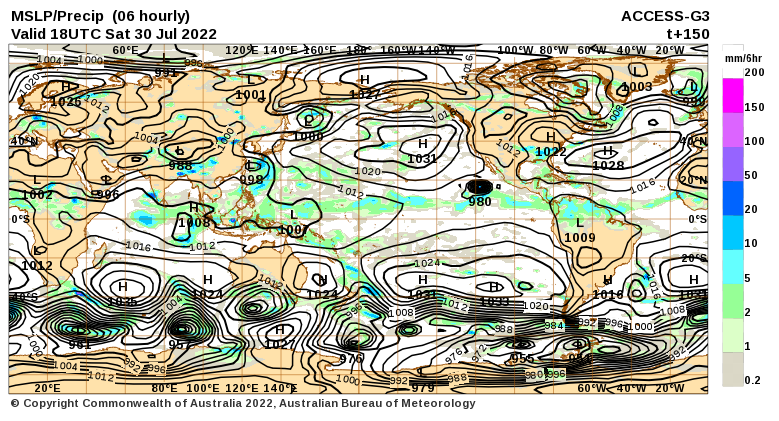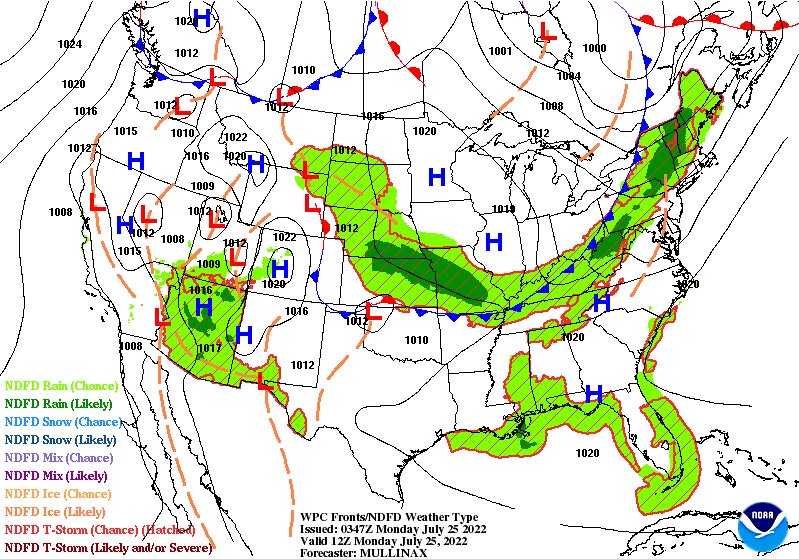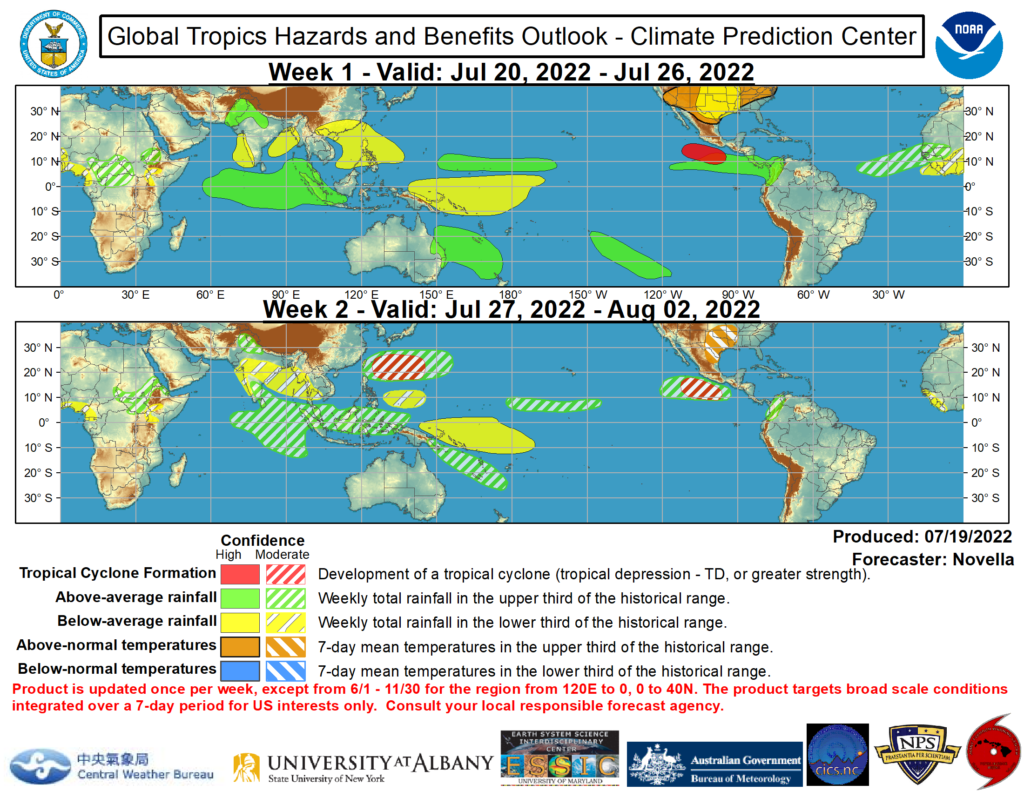Here is what we are paying attention to this evening and the next 48 hours from this evening’s NWS Forecast.
...Excessive heat to continue across portions of the Central Plains and Middle Mississippi Valley through Tuesday while Northeast and Mid-Atlantic moderate a bit.... ...Severe thunderstorms and excessive rainfall possible from Middle Mississippi Valley to Northeast... ...Monsoonal moisture to cause daily rounds of excessive rainfall and isolated flash flooding across portions of the Southwest and Southern Rockies through Tuesday...
Continuation of the NWS Short Range Forecast (It is updated twice a day and these updates can be found here.
Searing heat will continue across the Mid-Atlantic and Northeast tonight before the upper trough over Canada dips down into the region to moderate temperatures a bit tomorrow. Widespread low temperature records are forecast to be broken across the Mid-Atlantic and Northeast tonight as lows struggle to drop below the upper 70s and low 80s. 100F+ degree days to continue across parts of eastern Kansas/Oklahoma into southern Missouri and northern Arkansas over the next couple of days, due to a rigid area of high pressure remaining stationed over the region. Area wide heat index values likely to be between 105-111F on Monday. Anomalously warm temperatures visit the Pacific Northwest this week as an upper-level ridge amplifies over the region. High temperatures are forecast to steadily rise over the next few days leading to the possibility for records to be broken. Excessive heat watches, warnings and advisories are in effect for all of the aforementioned areas. Meanwhile, an elongated surface front will continue to be the focus for severe weather and flash flooding risk from the Central Plains/Rockies to the Northeast over the next several days. Rounds of convection will impact portions of the Ohio Valley and Lower Great Lakes tonight leading to the potential for localized heavy rainfall and severe thunderstorms. An Enhanced Risk of severe thunderstorms is in effect for parts of the Lower Great Lakes/interior Northeast for tonight as damaging wind gusts and tornadoes threaten the region. The severe weather threat shifts into the Northeast/Mid-Atlantic coast on Monday while the greatest flash flooding risk settles over the Central Appalachians and Middle Mississippi Valley through midweek due to the surface front stalling out. Elsewhere, impulses of upper-level energy will shoot up into the Southwest from Mexico allowing for monsoonal moisture to flow into the region. This will lead to heavy rain and flash flooding to take place over large swaths of Arizona the Four Corners and Colorado over the next couple of days. Slight Risks of excessive rainfall leading to flash flooding are in effect. Scattered to isolated thunderstorms will also impact those areas during this period.
Maps that relate the forecast to geography can be found by clicking Here for Day 1 and Here for Day 2.
Here is a 60-hour animated forecast map that shows how the short-term forecast is expected to play out.
If it needs to be updated click here.
HAZARDS OUTLOOKS
Click here for the latest complete Day 3 -7 Hazards forecast which updates only on weekdays. Once a week probably Monday or Tuesday I will update the images. I provided the link for reads to get daily updates on weekdays. Use your own judgment to decide if you need to update these images.
Worldwide Tropical Forecast
(This graphic updates on Tuesdays) If it has not been updated, you can get the update by clicking here
Detailed Maps and Reports for the Western Atlantic and the Pacific Oceans
Below are three maps that summarize the situation for the Atlantic, Eastern and Central Pacific. Additional information can be accessed by clicking HERE
First the Atlantic
Click to view the forecast map and have access to additional information https://www.nhc.noaa.gov/gtwo.php?basin=atlc&fdays=5
Then Eastern Pacific
Click to view the forecast map and have access to additional information https://www.nhc.noaa.gov/gtwo.php?basin=epac&fdays=5
Then Central Pacific
Click to view the forecast map and have access to additional information https://www.nhc.noaa.gov/gtwo.php?basin=cpac&fdays=5
And the Western Pacific
Click to view the forecast map and have access to additional information https://www.metoc.navy.mil/jtwc/jtwc.html
Some Intermediate-Term Outlooks
Links to “Outlook” maps and discussions for three time periods. Days 6 – 10, Days 8 – 14, and Weeks 3 and 4. An outlook differs from a forecast based on how NOAA uses these terms in that an “outlook” presents information from deviation from normal and the likelihood of these deviations.
You have to click on the links because they do not update automatically and I do not want to have stale images in the article. But it is not difficult to click on a link and you get a large image plus a discussion. On Fridays in a separate article, we will show the images and provide a link in this article that article. But remember what you will see is the images as of Friday. But here you can get the current images simply by clicking on them. Then hit the return arrow at the upper left of your screen to return to the article. You will not find this information easily anywhere else.
Right now you can find these maps here (We show them every Friday there but you can click above and find them).
Forecast for Day 6 (Currently Set for Day 6 but the reader can change that)
World Weather Forecast produced by the Australian Bureau of Meteorology. Unfortunately, I do not know how to extract the control panel and embed it into my report so that you could use the tool within my report. But if you visit it Click Here and you will be able to use the tool to view temperature or many other things for THE WORLD. It can forecast out for a week. Pretty cool. Return to this report by using the “Back Arrow” usually found top left corner of your screen to the left of the URL Box. It may require hitting it a few times depending on how deep you are into the BOM tool. Below are the current worldwide precipitation and air pressure forecasts for six days out. They will not auto-update and right now are current for Day 6. If you want the forecast for a different day Click Here I will try to update this map each day but you have the link so you can access the dashboard and get a wide variety of forecasts.
 I mostly rely on the reader to interpret world maps. For this map, areas of expected precipitation for the date and time shown are clearly shown.
I mostly rely on the reader to interpret world maps. For this map, areas of expected precipitation for the date and time shown are clearly shown.
The number of High-Pressure systems shown is called the Wave Number. Maybe I will discuss WN someday. But it shows how many Rossby Waves there are around the World. Sometimes they are hard to count. Counting Low-Pressure systems should provide the same WN. Rossby Waves are the way the temperature distribution of the Planet remains in balance. It is basically the science of fluid dynamics. It can be very helpful in predicting the movement of weather patterns.
Month to Date Information
(These images do not auto-update – I update them from time to time, but the links are there so just click on them)
Temperature
Precipitation
Month to date Temperature can be found at https://hprcc.unl.edu/products/maps/acis/MonthTDeptUS.png
Month to date Precipitation can be found at https://hprcc.unl.e du/products/maps/acis/MonthPNormUS.png







